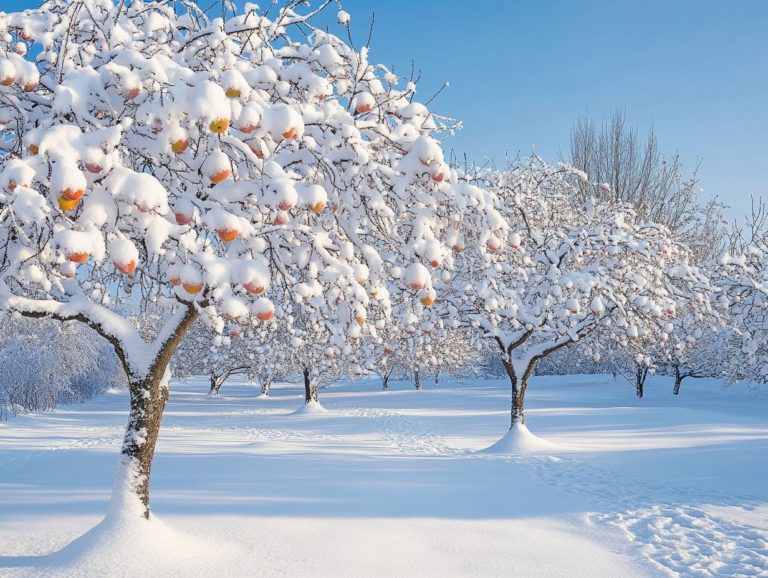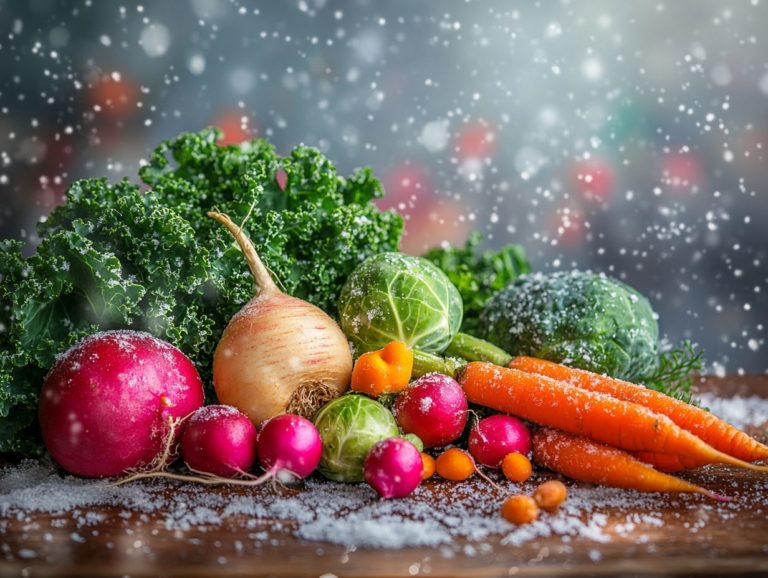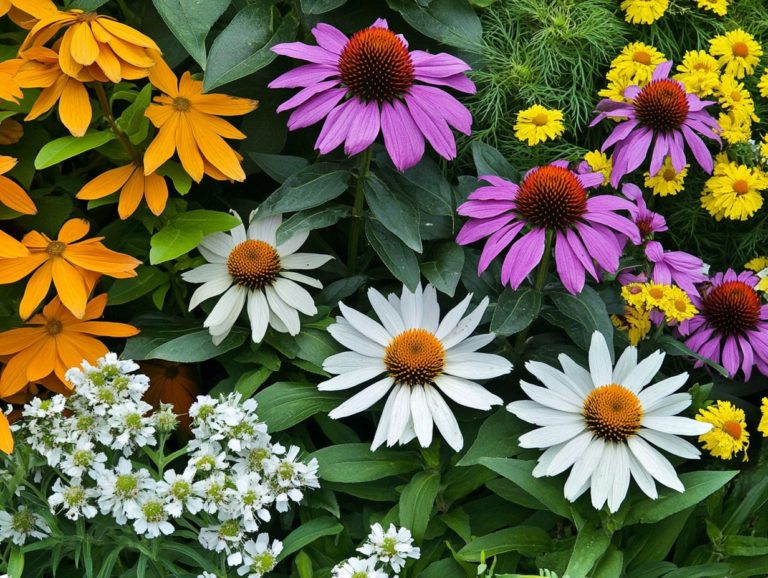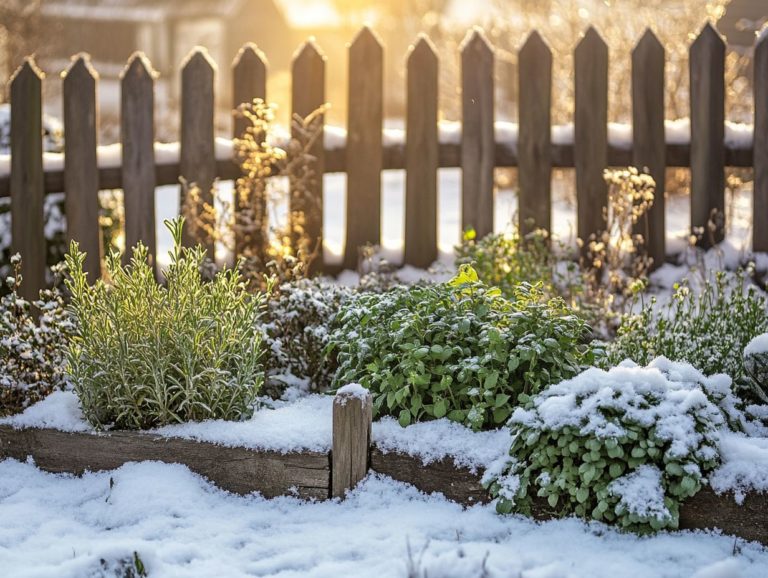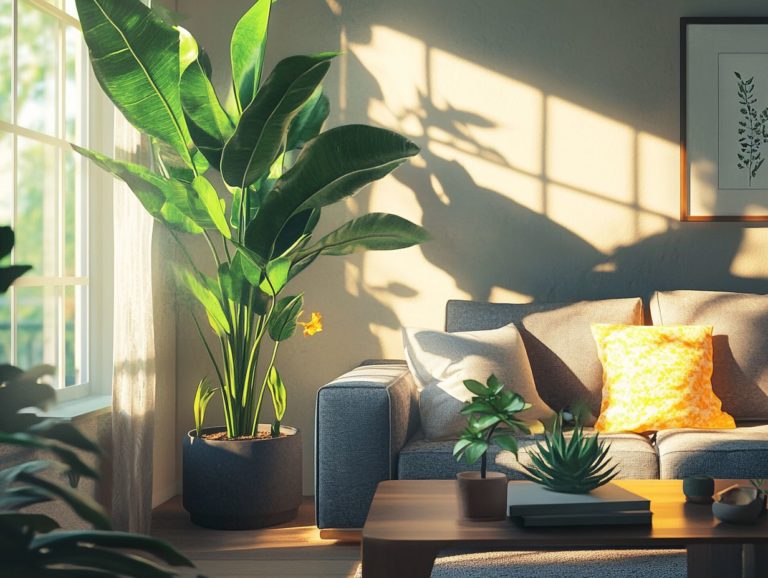Top 5 Shade-Tolerant Plants for Cold Climates
Creating a vibrant garden in a shaded area can be a delightful challenge, particularly in colder climates. This is especially true for gardening enthusiasts!
Choosing the right plants is crucial. Shade-tolerant varieties, like hostas and astilbes, truly excel in your garden plans. From the lush beauty of hostas to the delicate charm of bleeding hearts, you have a wealth of options that not only survive but thrive in low-light conditions.
This article delves into the top five shade-tolerant plants ideal for cold-climate gardening, complete with care tips, benefits, and design ideas for your shade garden.
Ready to transform your shady spots into stunning green retreats? Let s dive in!
Contents
- Key Takeaways:
- 1. Hostas
- 2. Bleeding Hearts
- 3. Ferns
- 4. Astilbes
- 5. Hellebores
- What Are Shade-Tolerant Plants?
- What Are the Benefits of Having Shade-Tolerant Plants in Cold Climates?
- What Are the Key Factors to Consider When Choosing Shade-Tolerant Plants for Cold Climates?
- How Can One Care for Shade-Tolerant Plants in Cold Climates, Especially When Considering the Unique Needs of Each Species?
- What Are Some Other Shade-Tolerant Plants That Can Thrive in Cold Climates?
- What Are Some Tips for Designing a Garden with Shade-Tolerant Plants in Cold Climates?
- Frequently Asked Questions
Key Takeaways:
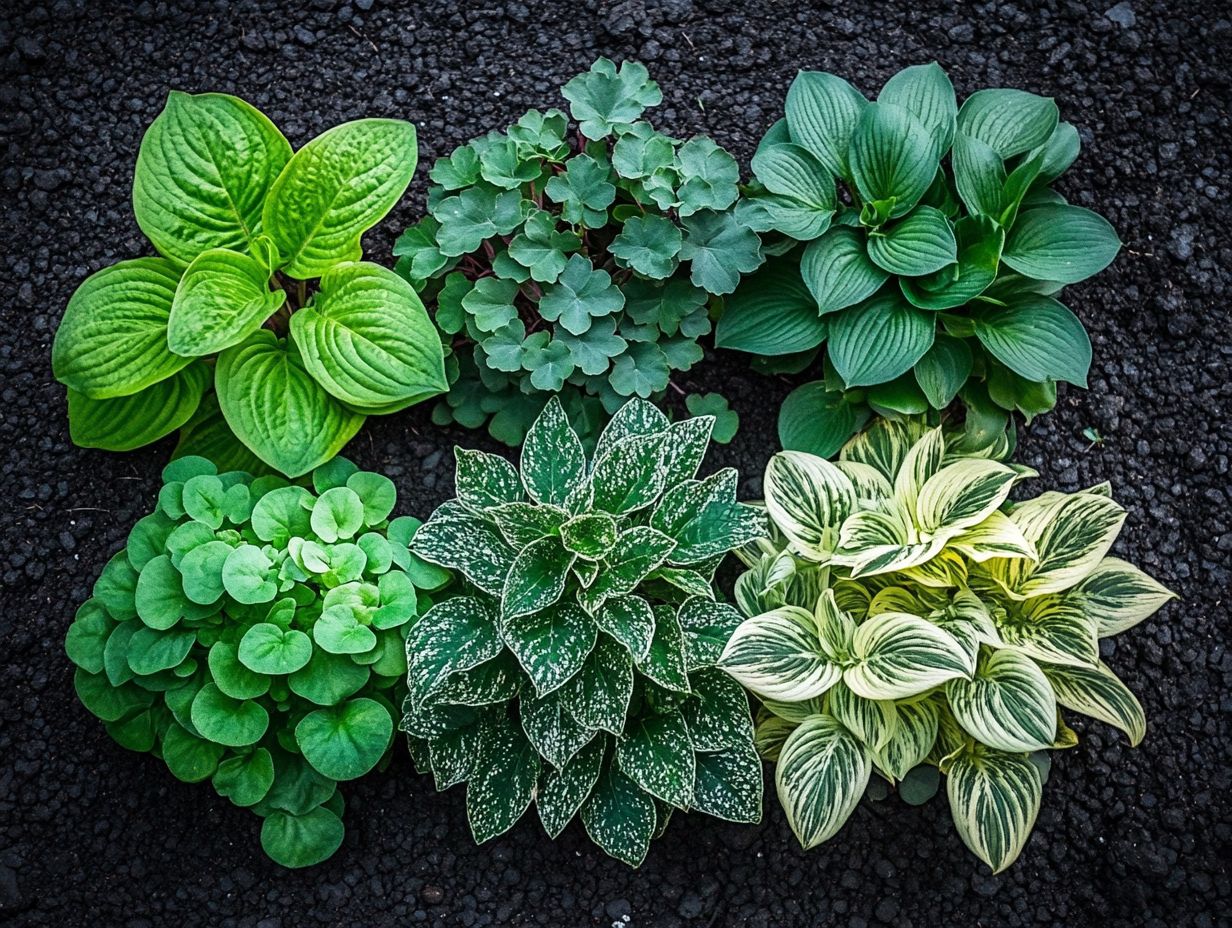
- Hostas, bleeding hearts, ferns, astilbes, and hellebores are top shade-tolerant plants for cold climates.
- These plants add color and texture to your landscape while providing shelter for wildlife.
- Consider hardiness, soil conditions, and sunlight when choosing shade-tolerant plants.
1. Hostas
Hostas are an exceptional choice for your shade garden, celebrated for their lush foliage and versatility across various plant hardiness zones. They provide a perfect way to introduce vibrant perennials into your outdoor space while ensuring resilience against cold-climate conditions, including biting sub-zero temperatures.
With a wealth of varieties at your disposal, you can choose the striking Hosta ‘Sum and Substance’, featuring its eye-catching yellow leaves, or the graceful Hosta ‘Blue Angel’, known for its silvery-blue foliage. Hostas thrive in well-drained soil that’s rich in organic matter and flourish in dappled sunlight or full shade.
To keep them happy, regular watering and mulching will help retain moisture and keep those pesky weeds at bay. Their adaptability allows for stunning combinations with other hardy plants, such as ferns, astilbes, and even perennial geraniums.
You can craft lush, layered landscapes that will transform any shaded area into a vibrant oasis.
2. Bleeding Hearts
Bleeding hearts are enchanting shade-loving plants that add a distinctive charm to your cold-climate garden and pair beautifully with columbine. Their heart-shaped blossoms and lush foliage create a vibrant display that captivates throughout the growing season.
To truly thrive, these beauties prefer well-draining, fertile soil enriched with organic matter. Consistent moisture is key; they shine brightest when the soil remains evenly moist.
As for sunlight, they lean towards partial shade, relishing dappled light without the harshness of the midday sun. This is essential for maintaining their vibrant colors and overall health.
In a shade garden, bleeding hearts pair wonderfully with other vibrant perennials, such as:
- Hostas
- Ferns
- Astilbes
These companions provide a delightful textural contrast while harmonizing beautifully with the soft pink and white hues of the blooms. This combination elevates the overall aesthetic of your garden sanctuary, especially when combined with evergreen shrubs for year-round interest.
3. Ferns
Ferns are a splendid addition to your shade garden. They introduce unique textures and vibrant greenery, making them essential components for any cold-climate gardening project.
If you’re seeking hardy plants that can thrive under the challenges of shade, ferns are an excellent choice, especially varieties like Ophiopogon planiscapus and Uncinia rubra.
With a delightful variety of species, from the delicate maidenhair fern to the robust ostrich fern, you can find options that fit your style and garden designs, like those with rich variegation.
Their care is straightforward, requiring consistently moist soil and filtered light. This makes them ideal companions for other shade-loving beauties like hostas, astilbes, and even Viburnum tinus.
The large, feathery fronds of ferns add depth and dimension, crafting a layered look that elevates the visual appeal of your shade garden. This effect is especially striking when combined with the stunning blooms of astilbes.
When positioned thoughtfully, ferns can seamlessly blend with flowering perennials, creating a lush, inviting atmosphere that beckons you to enjoy the tranquility of your outdoor space.
4. Astilbes
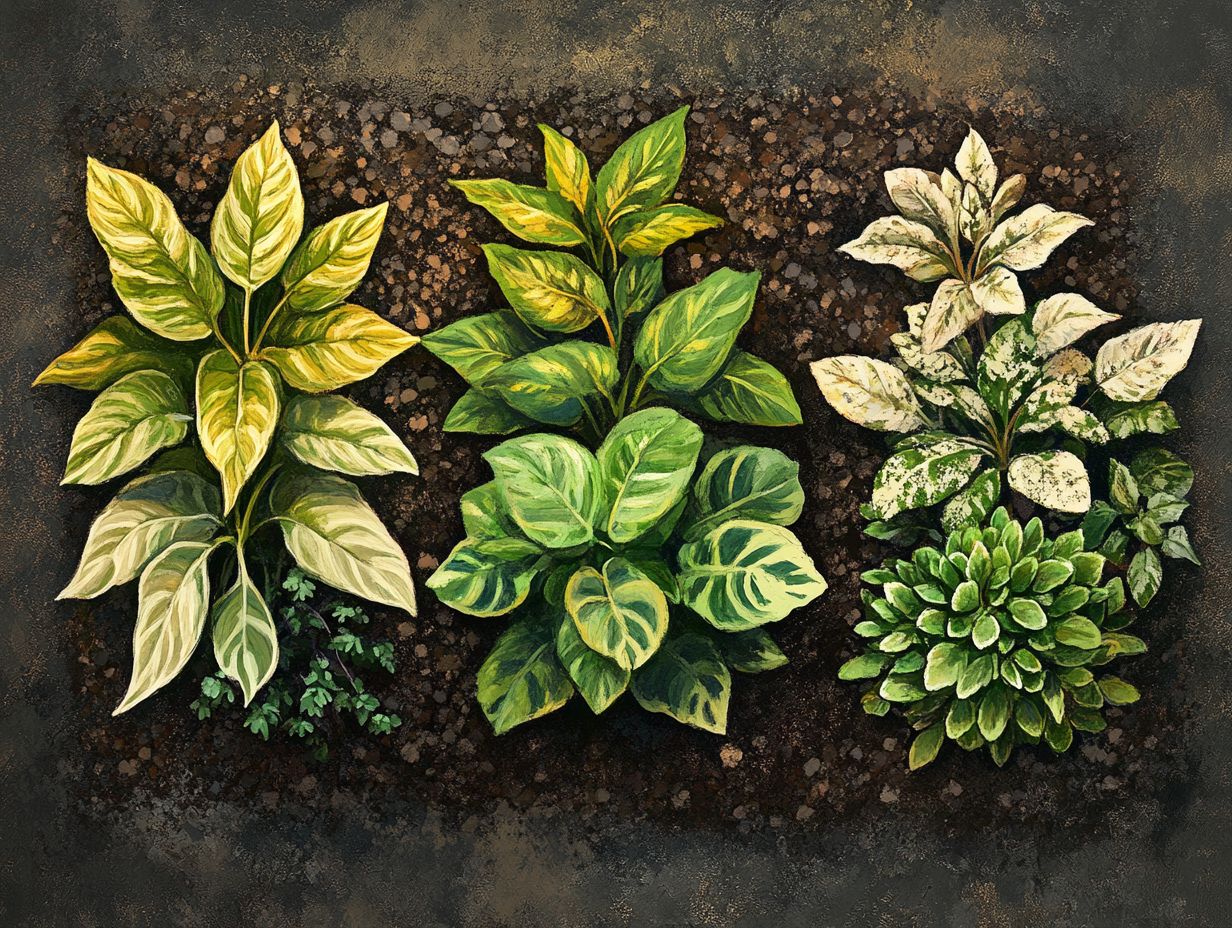
Astilbes are stunning shade-loving plants. They can transform your garden into a vibrant oasis, especially when planted alongside bleeding hearts.
With their captivating plumes of colorful flowers, astilbes thrive in cold-climate gardens. They bring life to shaded areas with their lush foliage and vibrant hues, ideal for creating eye-catching garden plans.
You ll find a variety of species, such as Astilbe chinensis and Astilbe arendsii. Each offers a bloom time that can stretch from early summer to late summer, making them some of the most vibrant perennials in any garden.
For optimal growth, these beauties prefer consistently moist, well-drained soil. Don t forget to mulch! This practice retains moisture and benefits neighboring plants like perennial geranium and the elegant ladys mantle.
Plan your shade garden by mixing astilbes with other perennials like ferns and hostas. This will create an exciting and diverse plant palette, enhancing visual appeal and fostering a dynamic ecosystem.
Their unique textures and colors create a beautiful space that benefits both your existing plants and the local wildlife.
5. Hellebores
Hellebores, often known as Lenten roses, are your go-to resilient shade plants. They grace your garden with beautiful blooms in early spring, attracting early-season pollinators.
These perennial flowers bring a touch of elegance to even the most shaded corners. They thrive beautifully in cold-climate gardens and pair well with other elegant plants like Euonymus fortunei.
You ll find these hardy perennials available in a stunning array of colors think white, pink, purple, and even delicate greenish hues. This versatility enhances the overall color palette of your shade garden.
When adding hellebores to your shaded landscape, consider pairing them with other shade-loving plants like hostas, ferns, and the vibrant Osmanthus x fortunei. These combinations can truly enhance the visual appeal.
To ensure optimal growth, plant hellebores in well-draining soil and remember to water them during dry spells. A layer of mulch will help retain moisture, giving them the best chance to flourish.
With the right care, your hellebores will thrive for many years, creating a captivating layered effect that delights the eye long after their blooms have faded. This enriches the overall biodiversity of your garden.
What Are Shade-Tolerant Plants?
Shade-tolerant plants, like Astilbe and Hosta, thrive in low-light conditions. They’re perfect for gardens with minimal sunlight.
These resilient beauties can survive sub-zero temperatures while adding charm to your landscape. They also support local wildlife, enhancing biodiversity.
By adding these plants to your garden, you create lush, layered landscapes. This not only invites admiration but also promotes ecological balance.
What Are the Benefits of Having Shade-Tolerant Plants in Cold Climates?
Shade-tolerant plants offer a wealth of benefits in cold climates. For those looking to maximize their gardening efforts, check out these top tips for planting in cold climates. They enhance your garden’s appeal and create a sanctuary for wildlife.
These plants attract pollinators and beneficial insects like bees and butterflies, essential for a balanced ecosystem. Their root systems help prevent soil erosion, crucial for maintaining a healthy landscape.
They thrive in the dappled light under trees, adding lush foliage to areas that may seem barren. This creates an inviting atmosphere that everyone will love!
By incorporating these species, you can blend beauty and functionality in your garden. Transform shaded spots into vibrant spaces today!
What Are the Key Factors to Consider When Choosing Shade-Tolerant Plants for Cold Climates?
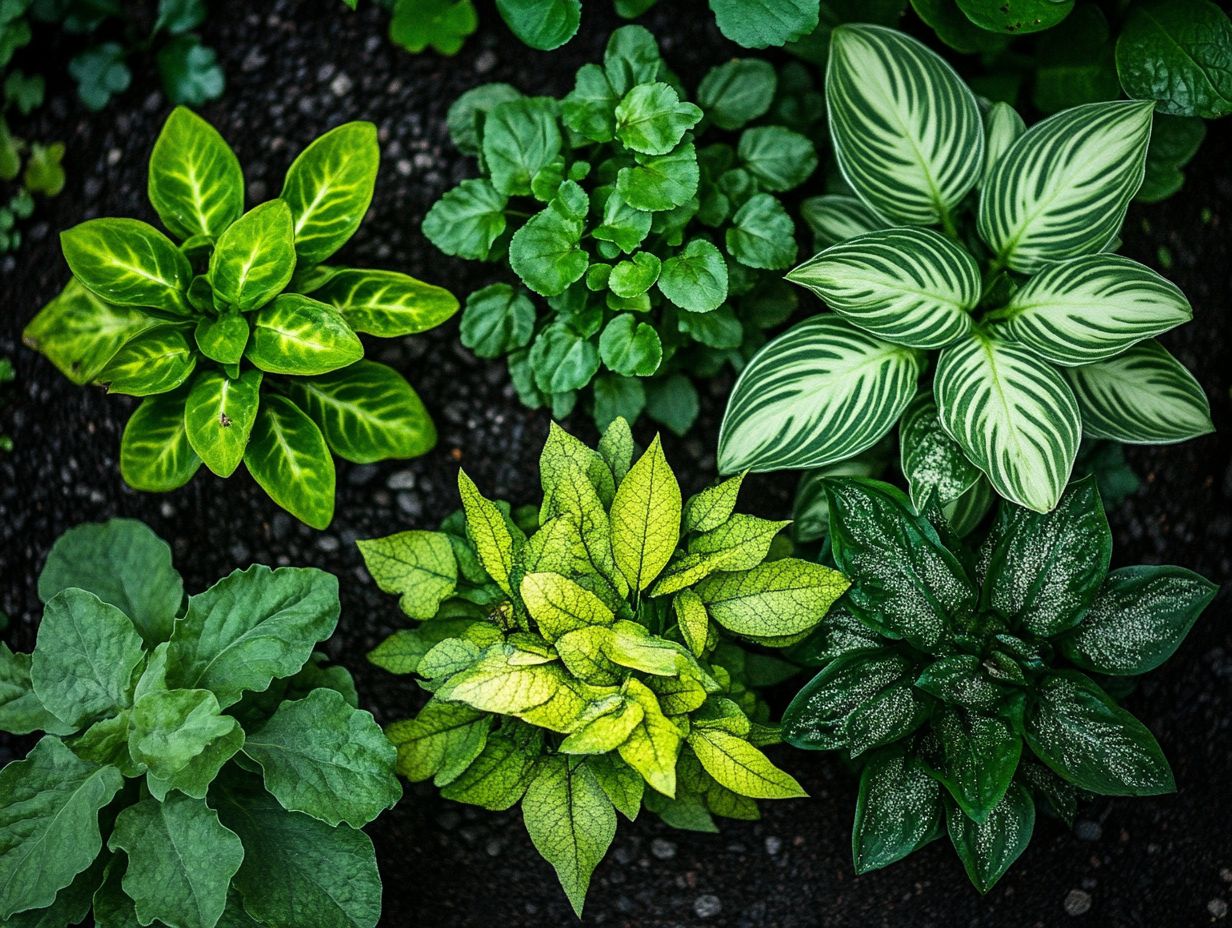
When choosing shade-tolerant plants, consider your specific USDA Hardiness Zone (a gardening map indicating plant survival temperatures), soil conditions, moisture levels, and the unique light requirements of each plant. This thoughtful approach is key to creating a thriving garden.
Understanding these factors impacts the health of your garden. Start by checking your Hardiness Zone to find suitable plants.
Soil condition whether well-drained or compact affects root growth and nutrient absorption. Assessing moisture levels helps you pick plants that thrive in damp or drier conditions.
Some plants, like Fatsia japonica, can handle partial sunlight, while others prefer full shade. Evaluate these factors to curate a diverse array of thriving plants.
How Can One Care for Shade-Tolerant Plants in Cold Climates, Especially When Considering the Unique Needs of Each Species?
Caring for shade-tolerant plants in cold climates demands attention to soil health, proper watering techniques, and seasonal preparation. These practices ensure these resilient plants flourish through winter’s challenges.
-
First, focus on soil quality. It should be well-draining yet capable of retaining moisture. Incorporating organic matter is crucial. Using Aucuba japonica can also enhance soil quality. When you water, aim for a deep soak during dry spells. However, tread lightly overwatering can lead to root rot, which is undesirable.
-
Mulching around the base of your plants is essential. It helps retain moisture and regulates soil temperature. This provides a buffer against extreme shifts. As winter approaches, take the time to prune dead or damaged branches. This not only enhances appearance but also encourages healthy growth come spring, making room for plants like Fatsia japonica.
-
Finally, don t overlook protective measures. Using burlap wraps or adding layers of mulch can shield your plants from harsh winds and freezing temperatures. This ensures they not only survive but thrive through the coldest months, just as Osmanthus x fortunei does in similar conditions.
What Are Some Other Shade-Tolerant Plants That Can Thrive in Cold Climates?
Beyond the well-known varieties, you ll discover a wealth of shade-tolerant plants that thrive in cold climates. This gives you a stunning array of colorful perennials and resilient plants to enhance the beauty of shaded areas all year round.
Take the vibrant Japanese painted fern, for instance. Its striking silver and green fronds add an artistic touch, making it a delightful addition to any woodland garden. Then there s the hardy geranium, celebrated for its long blooming season and ability to create a lush ground cover that offers both color and texture, much like Viburnum tinus.
The delicate blooms of the bleeding heart infuse an enchanting charm into your garden. Meanwhile, hostas, with their diverse foliage colors and sizes, provide captivating architectural interest. If you re feeling creative, mixing these plants, including Trachelospermum jasminoides, can yield breathtaking displays. These displays evolve with the seasons, transforming those dreary corners of your garden into vibrant showcases.
What Are Some Tips for Designing a Garden with Shade-Tolerant Plants in Cold Climates?
Designing a garden filled with shade-tolerant plants in cold climates requires meticulous attention to plant placement, color coordination, and layering. Using Sarcococca ruscifolia for layering can be particularly effective. Your goal is to craft a visually stunning and harmonious landscape that thrives in low-light conditions.
To enhance this unique environment, focus on selecting complementary colors that elevate the serene atmosphere of shaded areas. Incorporating variegated leaves, such as those found on Euonymus fortunei, can add striking visual interest. A diverse range of textures from the smoothness of ferns to the ruggedness of bark introduces depth to the garden s design.
Being mindful of seasonal shifts is crucial. Choosing plants that bloom at various times ensures your garden retains its charm throughout the year. Thoughtful combinations will not only enhance the aesthetic appeal but also introduce beautiful specimens like Ardisia japonica. These create layers that capture the eye, making each visit to your shade garden a fresh and delightful experience.
Frequently Asked Questions
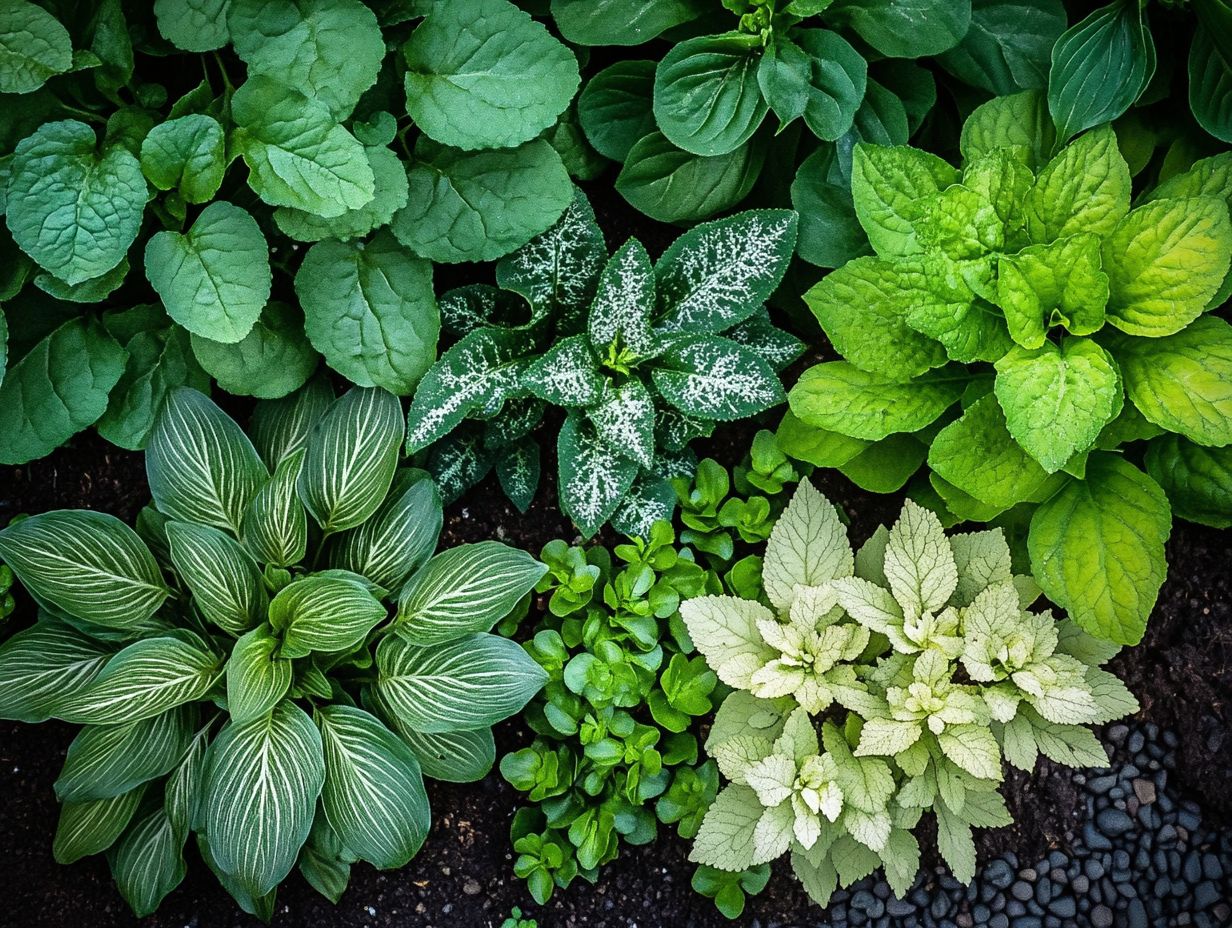
What are the top 5 shade-tolerant plants for cold climates?
The top 5 shade-tolerant plants for cold climates are hostas, hydrangeas, rhododendrons, ferns, and hellebores. For those interested in expanding their options, check out the top 5 shrubs for cold-climate gardens, which include vibrant choices like Uncinia rubra.
What is a shade-tolerant plant?
A shade-tolerant plant is one that can thrive and grow in low light conditions, such as in shade or partial shade.
Why are these plants recommended for cold climates?
These plants thrive in cool temperatures. They can also grow well in shady areas, making them ideal for cold regions.
How do I care for these plants in cold climates?
Plant these in well-draining soil. Water them regularly, but avoid overwatering, and shield them from harsh winds by placing them near sheltered spots.
Can these plants also grow in warmer climates?
While they prefer cold climates, some like hydrangeas and ferns might surprise you by thriving in warmer areas. Just ensure they are in shady spots and receive enough water without direct sunlight.
Are these plants suitable for indoor growing?
Many of these plants, such as ferns and hellebores, can flourish indoors. Place them in well-lit areas with indirect sunlight, but keep in mind they may not grow as robustly as outdoors.


